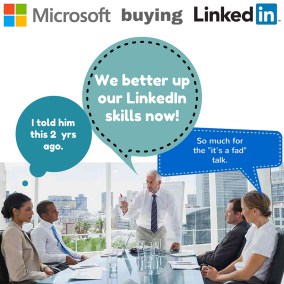What the LinkedIn Acquistion by Microsoft Means to Social Selling
June 14, 2016
Wow. Microsoft’s acquisition of LinkedIn for $ 26.2 billion is one of the largest tech acquisitions since the original dot-com era, when AOL spent $ 162 billion to buy Time Warner.
As someone with 20+ years in the software industry before spending the last five training companies how to use LinkedIn to increase sales , I have a few thoughts on this historical acquisition.
The Commonality of Consumer + Business Products Should Help
 Microsoft has been successful at blending consumer and business software. It started in 1975 as the operating system (OS) for the nascent PC (personal computer). It grew to become the No. 1 OS and office productivity software for individuals and businesses. LinkedIn started in 2003 as a freemium SaaS app for consumers. Yes, it was designed for members’ careers, but it was individuals, not companies that fueled LinkedIn origins. After amassing a large number of members, LinkedIn began to monetize the member-supplied data via enterprise applications for businesses. Now LinkedIn has three divisions selling to companies – Recruiting, Marketing, and Sales Solutions.
Microsoft has been successful at blending consumer and business software. It started in 1975 as the operating system (OS) for the nascent PC (personal computer). It grew to become the No. 1 OS and office productivity software for individuals and businesses. LinkedIn started in 2003 as a freemium SaaS app for consumers. Yes, it was designed for members’ careers, but it was individuals, not companies that fueled LinkedIn origins. After amassing a large number of members, LinkedIn began to monetize the member-supplied data via enterprise applications for businesses. Now LinkedIn has three divisions selling to companies – Recruiting, Marketing, and Sales Solutions.
The Open vs. Closed Mindset Could Clash
Microsoft built its dominance because it’s OS worked on a large number of computing hardware platforms. That required an open mindset to work with hardware partners like IBM Compaq, Osborne, Gateway, and others. It’s consumer software (Word, PowerPoint, Excel, Outlook) flourished in the 80s and 90s due, in part, to Microsoft’s ability to work with large computer retailers like CompUSA and Computer City. (Yes, kids, you used to drive the car to a store to buy software in a box!).
Microsoft built its business software division by partnering with a network of more than 640,000 VARs (Value Added Resellers). LinkedIn has taken the opposite approach. Ironically, the social network is not very social when it comes to working with partners. LinkedIn’s “walled garden” actions include cutting off APIs to LinkedIn data and building out it’s own professional services department for enterprise customers rather than follow a partner ecosystem like Microsoft and Salesforce.com.
It’s Mostly About Beating Salesforce.com
 At its core, this deal is about competing with Salesforce.com in the CRM space. Most CRM market share studies put Salesforce.com at No.1 with around 18% of the market followed by SAP, Oracle, and MSFT at around 6%. In a Business Insider interview with CEOs Satya Nadella and Jeff Weiner, Nadella says “”this is really all about expanding the opportunity we have, going beyond productivity and collaboration tools to having a professional network,” Nadella said. “It helps us differentiate our CRM product with social selling. It helps us take Dynamics [Microsoft’s suite of business management software] into new spaces like human capital management with recruiting, and learning, and talent management.”
At its core, this deal is about competing with Salesforce.com in the CRM space. Most CRM market share studies put Salesforce.com at No.1 with around 18% of the market followed by SAP, Oracle, and MSFT at around 6%. In a Business Insider interview with CEOs Satya Nadella and Jeff Weiner, Nadella says “”this is really all about expanding the opportunity we have, going beyond productivity and collaboration tools to having a professional network,” Nadella said. “It helps us differentiate our CRM product with social selling. It helps us take Dynamics [Microsoft’s suite of business management software] into new spaces like human capital management with recruiting, and learning, and talent management.”
 Last year, the Salesforce.com and LinkedIn relationship grew cold as LinkedIn started to add some CRM-like features. Expect some exciting LinkedIn integrations between both Dynamics as well as with good old Outlook.
Last year, the Salesforce.com and LinkedIn relationship grew cold as LinkedIn started to add some CRM-like features. Expect some exciting LinkedIn integrations between both Dynamics as well as with good old Outlook.
Of course, it will take a while for most of these changes to occur. In the meantime, I wouldn’t count on getting any LinkedIn swag at a Dreamforce booth this year.
How well is your sales team using LinkedIn?
Digital & Social Articles on Business 2 Community
(47)


